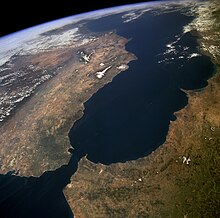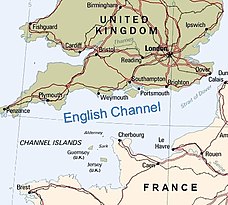Choke point
This article needs additional citations for verification. (August 2008) |

In
Historical examples
Some historical examples of the tactical use of choke points are King
The many archipelagos of the
Some choke points, with important locations in parentheses:
- Strait of Hormuz between Oman and Iran at the entrance to the Persian Gulf
- Bab-el-Mandeb passage from the Arabian Sea to the Red Sea (Yemen and Socotra)
- Strait of Malacca and the Singapore Strait between Malaysia and Sumatra (Indonesia)
- Panama Canal and the Panama Pipeline connecting the Pacific and Atlantic Oceans
- Suez Canal and the Sumed Pipeline connecting the Red Sea and Mediterranean Sea (Egypt)
- Khyber Pass between Afghanistan and Pakistan
- Strait of Gibraltar along the Atlantic Ocean entering the Mediterranean Sea (Spain, Gibraltar and Morocco)
- Strait of Dover or English Channel separating the Atlantic Ocean and the North Sea (England and France)
- Waterbodies connecting the Pacific and Atlantic oceans including:
- Strait of Magellan (Chile)
- Beagle Channel (Chile and Argentina)
- Drake Passage
- The Cape of Good Hope (South Africa)
- United States of America and Russia)
- Bosporus Strait linking the Black Sea (and oil coming from the Caspian Sea region) to the Mediterranean Sea (Turkey)
- Dardanelles Strait connecting the Sea of Marmara with the Aegean Sea (Turkey)
- Strait of Tartary along Sea of Japan and Sea of Okhotsk (Russia)
The Fulda Gap was seen as one of the potentially decisive bottleneck battlegrounds of the Cold War in Germany.
From the 18th to the early 20th centuries, the sheer size of the United Kingdom's Royal Navy meant it had control over much of the world's oceans and seas. Choke points were of huge importance to the British Empire, which often used them to control trade in British colonies and, to a lesser extent, for defense. Choke points have also been a source of tension, notably during the Suez Crisis. The Royal Navy still deems its choke points as strategically vital. Indeed, the importance of choke points was first recognised by British Admiral John Fisher.[1]

These are major British choke points today:
- The English Channel
- GIUK gap (between Greenland, Iceland, and UK)
- Strait of Gibraltar
The choke points still have significant strategic importance for the Royal Navy. The GIUK gap is particularly important to the Royal Navy, as any attempt by northern European forces to break into the open Atlantic would have to do so through the heavily defended English Channel, which is also the world's busiest shipping lane, or through one of the exits on either side of Iceland. Considering British control over the strategic fortress of Gibraltar at the entrance to the Mediterranean, Spain (northern coast), France (Atlantic coast) and Portugal are the only mainland European nations that have direct access to the Atlantic Ocean in a way that cannot be easily blocked at a choke point by the Royal Navy. The GIUK gap was also a strategically important part of the Cold War, as the Royal Navy were given the responsibility of keeping an eye on Soviet submarines trying to break into the open Atlantic.[citation needed]
Importance
Choke points remain a prominent issue today[
The Suez Canal and the Sumed pipeline carry 4.5 million barrels (190,000,000 US gal; 720,000 m3) a day, and the canal carried a total of 7.5% of world trade in 2011.[7] The canal was closed for eight years after the Six-Day War in 1967. In many instances, alternate routes are nonexistent or impractical. For example, an alternate to the Suez/Sumed route required an additional 6,000 miles (9,700 km) around Cape of Good Hope.[8] The Royal Navy also still deems its choke points to the Atlantic as strategically important.
Threats to the Strait of Hormuz
The
See also
- Land (economics)
- Strategic geography
- Sea lines of communication
- String of Pearls (China)
References
- ISBN 978-1-84724-776-6.)
{{cite book}}: CS1 maint: location (link - ^ Smith, Lee G. (2020). "Why U.S.–Iran Feud Keeps Focus on Strait of Hormuz". Bloomberg. Retrieved May 10, 2020.
- ^ Evans, D.; Heavens, L. (April 22, 2019). "Iran says ready for U.S. waivers end, as Guards threaten to shut Hormuz". Reuters. Retrieved May 10, 2020.
- ^ Cunnigham, E. (2020). "Top Iranian general warns U.S. against 'dangerous behavior' in Persian Gulf after Trump threat". The Washington Post.
- ^ "Strait of Hormuz". Crisis Group. December 14, 2017. Retrieved May 10, 2020.
- ^ Marcus, Jonathan (April 24, 2020). "War of words raises fresh fears of US–Iran Gulf clash". BBC News. Retrieved May 10, 2020.
- ^ "Egypt: Will U.S. And NATO Launch Second Suez Intervention?". Scoop.co.nz. Retrieved November 26, 2014.
- ^ "World Oil Transit Chokepoints" (PDF). U.S. Energy Information Administration. July 25, 2017. Retrieved September 23, 2020.
- ISBN 978-0700710980.
- ^ Katzman, K., Nerurkar, N., O'Rourke, R., Mason, R. C. & Ratner, M. 2012. Iran’s Threat to the Strait of Hormuz, CRS Report for Congress.
- ^ Lahabi, Omid (June 28, 2019). "Strait of Hormuz: Why does Iran threaten to close it?". euronews. Retrieved May 10, 2020.
- ^ Kahl, C. H. (2012). "Not Time to Attack Iran: Why War Should Be a Last Resort". Foreign Affairs. 91: 166–173.
- ^ Rezaei, F. (2019). "Iran's Military Capability: The Structure and Strength of Forces". Insight Turkey. 21: 183–214.
- ^ Sutton, H. I. "Iran Deploys Missiles Covering The Strait Of Hormuz". Forbes. Retrieved May 10, 2020.
- ^ Henseler, S. P. (2018). "Left of Splash" Legal Issues Related to the Use of Force to Counter Mining in the Strait of Hormuz. In: Schildknecht, J., Dickey, R., Fink, M. & Ferris, L. (eds.) Operational Law in International Straits and Current Maritime Security Challenges. Springer.
- JSTOR j.ctt6wrj9g.
- S2CID 154650063.
- ^ Hicks, K. H. & Dalton, M. G. 2017. Deterring Iran after the Nuclear Deal, Rowman & Littlefield.
- ^ University, Rockford Weitz, Tufts (January 7, 2020). "Explainer: Could Iran close the Strait of Hormuz?". Navy Times. Retrieved May 10, 2020.
{{cite web}}: CS1 maint: multiple names: authors list (link) - ^ Yadlin, A.; Guazansky, Y. (2012). "The Strait of Hormuz: Assessing and Neutralizing the Threat". Strategic Assessment. 14.
